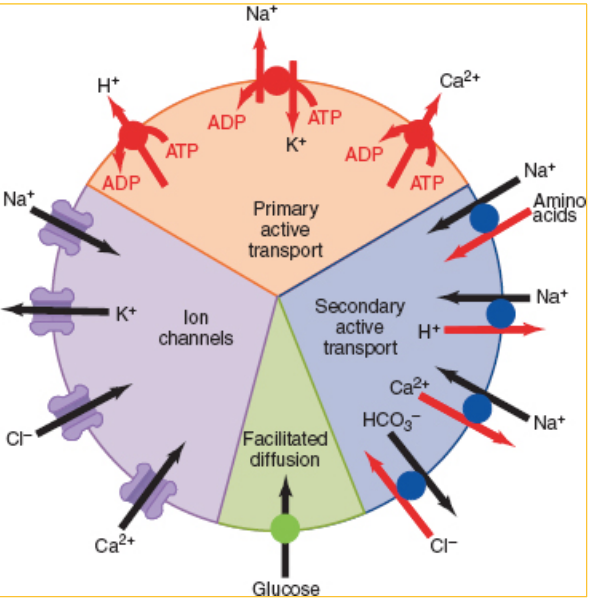4 & 5 Human Physiology
4.1 Diffusion
Simple diffusion: Random movement of molecules due to thermal motion
Net diffusion: Always occurs down a concentration gradient
Diffusion does not require energy nor binding to a transporter protein
Flux: The amount of a substance crossing a membrane per unit time
Net flux: The difference between two one-way fluxes
The magnitude of diffusion flux across a membrane is determined by
Concentration gradient
Bigger difference in concentraion increases flux
Temperature
Higher temperature increases flux
Mass of molecule
Larger molecules have a harder time diffusing
Surface area of membrane
Larger surface area makes more opportunity for substances to permeate
Diffusion medium
Easier travel through water than oil
Diffusion distance
Smaller distance traveled means more flux
Membrane permeability
Lipid bilayer: The limiting factor for diffusion across cell membranes
Simple diffusion: The type of diffusion by while non-polar molecules readily move
Polar or charged molecules cannot readily cross a cell membrane via simple diffusion
Channel Diffusion
Ions can only move down a concentration gradient if channels are present in the plasma membrane
Ion Channels
Ion channels allow downhill movement of ions
Ion channels do not require binding
Ion channels can either be open or closed to allow movement
Ion channels are selective for their specific ions (sodium vs potassium channels)
Movement of ions across membrane influenced by electrical gradient as well as concentration gradient
Inside of cell has negative membrane potential
Intracellular fluid attracts cations and repels anions
Electrochemical gradient: The net flux in and out of a cell is ultimately determined by this gradient.
Regulation of ion channels (aka gates)
Ligand-gated: Cell membrane channels that open on one side of the cell membrane to open or close to passage
Voltage-gated: Channels that rely on electrical signals to move open or closed
Mechanically-gated channels: Channels of a cell membrane that must move themselves open or closed using energy
Leak: Non-gated cell membrane channels
Osmosis
Osmosis: Net diffusion of water from a region of higher water concentration to a region of lower concentration
Water concentration is inverselyrelated to solute concentration
Osmolarity: total moles of solute divided by Liters of solution
Aquaporins: Channels that allow the rapid passage of water through the cell membrane, necessary because water is polar
Permeable: If a membrane is fully _________ to water and solute, both will eventually reach equilibrium
Semi-permeable: If membrane is _____________ (only permeable to water), water will move to area of higher solute concentration
Mediated Transport
Mediated transport: The process by which the solute moves by binding to a transmembrane protein known as a transporter
Mediated transport flux is affected by number of transporters, affinity of transporters, and the rate of transporter conformation change
Facilitated diffusion, active transport: Two broad categories of mediated transport
Facilitated diffusion: A type of mediated transport that involves downhill movement, no energy required
In facilitated diffusion, Net flux continues until equilibrium reached
Active transport: A type of mediated transport that involves uphill movement and requires energy (ATP)
Primary: This Active Transport type occurs when energy comes directly from ATP hydrolysis
A sodium/potassium ATPase pump is an example of Primary Active Transport
Secondary: This Active Transport type occurs when energy comes from an existing ion gradient
Cotransport: A type of secondary active transport; Transported substance can move in same direction as Na+ and it kinda hitches a ride
Countertransport: A type of secondary active transport; Transported substance can move in opposite direction as Na+ where it kinda sneaks against the sodium flow

Endo & Exocytosis
Some substances enter/exit cell without passing through cell membrane or membrane-transporter, which is endo or exocytosis
Endocytosis: Cell membrane folds in from the outside to create a baby pocket, losing some cell membrane and requiring ATP, and is generally used for bulk movement.
Endocytosis moves stuff into the cell
Pinocytosis, phagocytosis, and receptor-mediated endocytosis are all types of endocytosis
Exocytosis: Vesicle fuses to te cell membrane to release stuff outside of the cell; replaces the membrane it lost during endocytosis; most secreted substances come from the Golgi apparatus
 Knowt
Knowt
